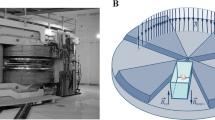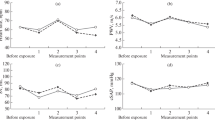Abstract
The uptake of131I by the thyroid gland and of thyroxine by the tissues of various organs, and also the protein-bound iodine (PBI) concentration in the blood plasma were studied in albino rats exposed to a variable magnetic field (VMF) with an intensity of 200 Oe, of industrial frequency, for different durations and at different intervals. In resonse to exposure for 15 min the PBI level rose. With an increase in the exposure to 6.5 h and, in particular, to 24 h the PBI level and thyroxine uptake by the tissues of the testes, heart, liver, and spleen fell. In the case of repeated exposure to a VMF (up to 6.5 h daily for 5 days) a significant increase was found in the131I concentration in the thyroid, gland and the PBI level, whereas thyroxine uptake by the tissues was considerably reduced. It is suggested that the state of the thyroid function and the tissue response to thyroxine are modified depending on the duration and rhythm of exposure to a magnetic field.
Similar content being viewed by others
Literature Cited
G. A. Vasil'ev, Yu. A. Medvedev, and O. K. Khmel'nitskii, The Endocrine System in Hypoxia [in Russian], Leningrad (1974).
L. Kh. Garkavi, E. B. Kvakina, and M. A. Ukolova, in: Regulation of Energy Metabolism and Resistance of the Organism [in Russian], Pushchino-on-Oka (1975), p. 172.
E. V. Gubler and A. A. Genkin, The Use of Nonparametric Statistical Criteria in Medico-Biological Research [in Russian], Moscow (1973).
I. L. Degen, Vrach. Delo, No. 3, 124 (1971).
I. L. Degen, Klin. Khir., No. 3, 75 (1971).
E. B. Kvakina and L. Kh. Garkavi, in: Physico-Mathematical and Biological Problems of the Action of Electromagnetic Fields and Ionization of the Air [in Russian], Moscow (1975), p. 52.
E. S. Kotlyarevskaya, “Investigation of the functional state of the hypothalamic region of the brain during the antitumor action of magnetic fields,” Author's Abstract of Candidate's Dissertation, Rostov-on-Don (1974).
A. Kh. Mirkhodzhaev and V. A. Rakova, Probl. Endokrinol., No., 2, 86 (1964).
Yu. B. Skebel'skaya, Probl. Endokrinol., No. 1, 111 (1963).
N. A. Udintsev, N. V. Kanskaya, et al., Byull. Éksp. Biol. Med., No. 6, 670 (1976).
N. A. Udintsev and V. V. Moroz, Pat. Fiziol., No. 6, 72 (1976).
S. M. Khlynin, in: The Biochemistry of Extremal States [in Russian], Chelyabinsk (1977), p. 24.
V. G. Yasnogorskii, Transactions of the Central Research Institute of Balneology and Physiotherapy [in Russian], No. 29 (1975), p. 87.
Rights and permissions
About this article
Cite this article
Udintsev, N.A., Serebrov, V.Y. & Tsyrov, G.I. Effect of a variable magnetic field of industrial frequency on thyroid function and tissue thyroxine uptake in rats. Bull Exp Biol Med 86, 1452–1454 (1978). https://doi.org/10.1007/BF00800282
Received:
Issue Date:
DOI: https://doi.org/10.1007/BF00800282




